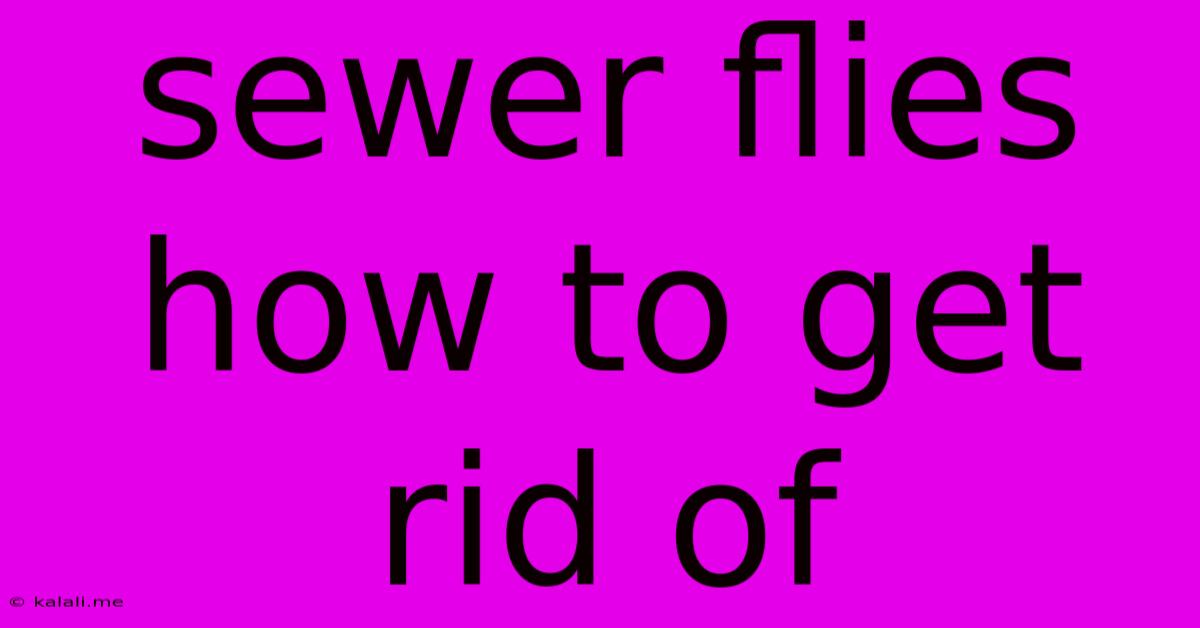Sewer Flies How To Get Rid Of
Kalali
May 24, 2025 · 3 min read

Table of Contents
Sewer Flies: How to Get Rid of These Persistent Pests
Sewer flies, also known as drain flies or filter flies, are tiny, annoying insects that often infest drains and sewers. Their presence is a clear sign of a hygiene issue, and their persistent buzzing and tendency to swarm can be incredibly frustrating. This article will guide you through identifying sewer flies and provide effective strategies on how to get rid of them and prevent future infestations. This includes tackling the root cause and implementing long-term solutions.
What are Sewer Flies?
Sewer flies are small, dark-colored flies, typically about 1/8 inch long, with fuzzy bodies and hairy wings. They're attracted to moist, decaying organic matter, making drains, garbage disposals, and other damp areas prime breeding grounds. Unlike fruit flies, they don't necessarily indicate a problem with spoiled food. Instead, their presence points to a buildup of organic sludge and biofilm within your plumbing system. Identifying them is the first step to effective sewer fly control.
Identifying a Sewer Fly Infestation:
- Swarms near drains: The most obvious sign is a swarm of small, dark flies congregating around drains, especially in bathrooms and kitchens.
- Slow-moving flight: Unlike other flies, sewer flies have a characteristic slow, erratic flight pattern.
- Dark, fuzzy bodies: Their bodies are typically dark brown or black and appear fuzzy or hairy.
- Moist environments: They tend to thrive in damp, poorly ventilated areas.
How to Get Rid of Sewer Flies: A Comprehensive Guide
Getting rid of sewer flies requires a multi-pronged approach focusing on eliminating breeding grounds and preventing future infestations. Here's a step-by-step guide:
1. Clean Your Drains Thoroughly:
This is the most crucial step. Sewer flies breed in the organic matter accumulating in your drains. A thorough cleaning can significantly reduce their population.
- Boiling Water: Pouring a kettle of boiling water down each drain can kill many larvae and dislodge organic matter. Repeat this several times a day for a few days.
- Baking Soda and Vinegar: Combine ½ cup baking soda followed by 1 cup of vinegar. The fizzing action helps to dislodge gunk. Follow up with hot water.
- Commercial Drain Cleaners: Use a drain cleaner specifically designed to break down organic material. Always follow the instructions carefully.
2. Address Plumbing Issues:
Sometimes, sewer flies indicate a more serious underlying plumbing problem. Check for:
- Leaks: Repair any leaks in your pipes to eliminate moisture that attracts flies.
- P-traps: Ensure your P-traps (the curved sections of pipe under your sinks and showers) are properly sealed and contain water. This water acts as a barrier, preventing sewer gases and flies from entering your home. If the P-trap is dry, this is a major breeding ground for sewer flies.
3. Prevent Future Infestations:
Once you've eliminated the existing flies, focus on prevention.
- Regular Cleaning: Clean your drains regularly using baking soda and vinegar or boiling water.
- Drain Screens: Use drain screens to prevent larger debris from entering your drains.
- Ventilation: Ensure adequate ventilation in bathrooms and kitchens to reduce moisture.
- Garbage Disposal Maintenance: Regularly clean your garbage disposal.
Natural Remedies for Sewer Fly Control:
While chemical drain cleaners can be effective, some prefer natural solutions. Essential oils, such as peppermint or tea tree oil, can deter flies. However, these are more effective as a preventative measure than as a solution to a large infestation.
When to Call a Professional:
If you've tried these methods and still have a persistent sewer fly problem, it's time to call a professional pest control service. They have access to more powerful treatments and can identify any underlying plumbing issues.
By following these steps, you can effectively eliminate sewer flies from your home and prevent future infestations. Remember that persistence and a proactive approach are key to keeping these pesky insects at bay.
Latest Posts
Latest Posts
-
Why Is Peter Walking On Water Only In Matthew
May 24, 2025
-
How To Cut Metal Flex Conduit
May 24, 2025
-
Why Did Jesus Call Simon Peter
May 24, 2025
-
How To Tear Down A Chimney
May 24, 2025
-
You Might Not Like Me Using This Word
May 24, 2025
Related Post
Thank you for visiting our website which covers about Sewer Flies How To Get Rid Of . We hope the information provided has been useful to you. Feel free to contact us if you have any questions or need further assistance. See you next time and don't miss to bookmark.